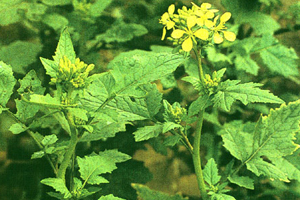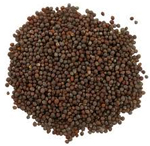|
|

|
|

| Latin Name : Brassica juncea |
| Family : Brassicaceae/ Cruciferae(cabbage family) |
| Genus : Brassica |
| Common names : mustard greens, leaf mustard, Indian mustard, brown mustard |
 |
Indigenous to the Mediterranean and Southern Europe, mustard is an erect, multi-branched herbaceous plant, valued for their intense flavours and healing properties. The name mustard comes from the Latin 'mustum ardens' or 'burning must', so named because the seeds were pounded with unfermented grape juice or 'must', to develop their pungent/burning qualities.
The mustard seed and the plant itself is grown for its beautiful yellow flowers and spicy seedling leaves. The species is widely cultivated in Europe, India and North America. The three most common types of mustard seed are the white or yellow, black and brown seeds. All over the world, mustard is used for its appetising flavour and preservative value and the seeds are used largely for tempering food. It is also used in medicines. Its basal leaves are eaten raw and used in salads or cooked like spinach. Leaves and stems are also added to soups and stews. Mustard is available in the form of seeds, powders, oil, and a myriad of prepared mustards. Mustard oil made from mustard seeds is used to pickle foods.
This cool-season annual has a 1 to 3 feet tall branched stem which is round and hairless. The 4 to 8" long bluish green leaves are deeply lobed on petioles with margins that have coarse or rounded teeth that are directed outward. It bears a 3 feet stalk supporting four petaled bright yellow flowers that soon develop into sickle-shaped green seed pods. It is a long, narrow, several-seeded silique, 1 to 3 inches long, ascending or spreading, with a prominent nerve on each valve. The pods of brown mustard contains upto 20 seeds, those of white mustard 8 seeds. Mustard seeds are nearly globular in shape about 2.5mm in diameter, finely pitted, odourless when whole, and pungent-tasting.
As a medicinal plant, mustard has traditionally been considered as a digestive irritant and stimulant. It has been used as a folk remedy against arthritis, rheumatism, inflammation, and toothache. It stimulates the kidneys and is also given as a laxative and emetic. A gargle of mustard seed in hot water is helpful in the relief of sore throats and bronchitis. Bathing in a few spoonfuls of mustard powder is said to relieve muscular aches and pains. Mustard plasters were formerly used in medicine for their counterirritant properties in treating chest colds. Mustard greens are an excellent source of vitamin E, vitamin C, and beta-carotene. They also contain vitamin B6, folic acid, magnesium, calcium, iron, niacin, vitamin A, and are an excellent source of phytochemicals thought to prevent cancer.
Propagation, Planting and Harvesting :

Mustard is very easy to cultivate and inexpensive to grow. They will grow in any type of soil preferably with a pH value between 4.2 to 8.3, which is fertile and well-drained. It likes a sunny spot, with some shade in summer.
Propagation of mustard is through seeds. The seeds can be sown directly into the ground which is enriched with well rotted manure and compost. Sow evenly, covering with 1/4" of soil and keep moist and free of weeds. Germination will take place within ten days.
Growing period is from 40–60 days, depending on variety and weather conditions. For mustard greens, plants are cut off at ground level when they are young and tender. They are big enough to pick after 30 days. Remove individual outer leaves and the harvesting can be continued from the same plants throughout the season. Plants are harvested before fruits are fully ripe to reduce shattering. The entire plants are either pulled out by hand or cut a few cm above ground with sickles. Plants are tied into small sheaves and dried in the sun for 4–10 days. Extraction of oil from the seed is by rotary mill, expeller, and hydraulic processes.
Problems and Care :
Disease rarely bothers this plant in the wild, although various insects often chomp holes in the foliage. Flea beetles, caterpillars, aphids, snails and slugs are the most frequent pests. Aphids (usually on the underside of the leaves), can be washed off under the cold water tap before cooking.
Questions & Answers |
|||||||||||||||||||||||||||||
| |||||||||||||||||||||||||||||
| |||||||||||||||||||||||||||||
| |||||||||||||||||||||||||||||
| » more... | |||||||||||||||||||||||||||||